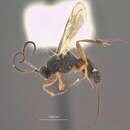Distribution
provided by Catalog of Hymenoptera in America North of Mexico
Calif.
- bibliographic citation
- Catalog of Hymenoptera in America North of Mexico. 1979. Prepared cooperatively by specialists on the various groups of Hymenoptera under the direction of Karl V. Krombein and Paul D. Hurd, Jr., Smithsonian Institution, and David R. Smith and B. D. Burks, Systematic Entomology Laboratory, Insect Identification and Beneficial Insect Introduction Institute. Science and Education Administration, United States Department of Agriculture.
Comprehensive Description
provided by Smithsonian Contributions to Zoology
Orgilus fallax
This species is very similar to frigidus, new species, but it may be distinguished by its somewhat longer ovipositor, relatively broader hind wings, barely postfurcal nervulus, smoother first tergite and relatively longer second tergite.
FEMALE.—Length about 4 mm. Head in dorsal view about 0.6 as long as wide, not wider than thorax at tegulae; face about 1.2 times as wide as eye height, strongly convex and closely and finely punctate, the interspaces on upper part of face shagreened; malar space half as long as eye height, finely granulose and mat; clypeus weakly punctate and shiny; cheeks shagreened and mat; temples 0.85 as wide as eyes, only slightly receding, smooth and polished adjacent to eyes, finely and rather broadly shagreened along occipital carina, which is broadly interrupted medially; vertex and back of head smooth and shiny; ocellocular line barely twice as long as diameter of an ocellus; antennae of holotype 30-segmented, none of the flagellar segments wider than long, the five preceding the apical segment distinctly longer than wide.
Thorax rather stout; mesoscutum very smooth and shiny, but the middle lobe with some very shallow and minute punctures; notauli sharp and very finely foveolate, meeting much before apex of scutum, a few punctures behind their junction; disc of scutellum convex and shiny; propodeum rugose, a small transverse, smooth and polished area each side of the middle at extreme base, the stubs of the longitudinal carinae that arise from the posterior margin rather prominent and extending forward at least one-third the way toward base, the lateral apical areas impressed and smooth and shiny; side of pronoturn finely rugulose in the impression, granulose along anterior margin and weakly shagreened and shiny along upper margin; mesopleuron smooth and polished, the longitudinal furrow finely foveolate, no punctures or other sculpture below the furrow and the surface in the upper anterior angle almost entirely smooth; metapleuron rugulose but weakly so in the upper anterior angle. Hind coxa strongly rugulose on upper edge and on upper part of outer side; hind femur twice as long as hind coxa and about five times as long as broad; inner calcarium of hind tibia slightly more than half as long as metatarsus; tarsal claws simple. Radial cell on wing margin about as long as stigma, the latter very narrow; second abscissa of radius on a line with intercubitus; stub of third abscissa of cubitus as long as second abscissa; nervulus barely postfurcal; hind wing 4.3 times as long as wide; lower abscissa of basella about as long as nervellus and much less than half as long as mediella.
Abdomen stout, at widest point nearly as wide as thorax; first tergite 0.8 as wide at apex as long, closely rugulose punctate except on basal third where it is smooth and shiny, the dorsal keels not developed, the spiracles about twice as far from each other as from the base of the segment; second tergite about 1.15 times as broad at base as long, broadening slightly caudad, and finely confluently punctate except narrowly at apex and along lateral margins; second suture fine but sharply impressed; third tergite with a small transverse area of weak punctures a little beyond base, otherwise smooth and polished like the following; ovipositor sheath about as long as propodeum and abdomen combined.
Black; palpi blackish; clypeus on lower third and the mandibles reddish yellow; trochanters not darkened; hind coxae blackish, especially above and toward bases; hind femora darkened above and inwardly; hind tibiae apically and all the tarsi more or less darkened; tegulae black, wing bases dark brown; wings a little infumated; abdomen black above, the apical margin of third tergite a little rufous; venter piceous.
MALE.—Unknown.
HOLOTYPE.—USNM 70162.
DISTRIBUTION.—Known only from the holotype female from Mt. Laguna, San Diego County, California, collected 23 May 1959, by J. Powell.
- bibliographic citation
- Muesebeck, Carl F. W. 1970. "The Nearctic species of Orgilus Haliday (Hymenoptera: Braconidae)." Smithsonian Contributions to Zoology. 1-104. https://doi.org/10.5479/si.00810282.30

